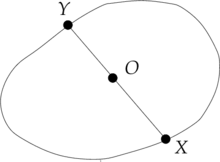Chordal problem
In the book[1] there is a generalization of the equichordal point problem attributed to R. Gardner.

- We consider a point inside a Jordan curve with the property that for any chord of the curve passing through the two parts and of the chord satisfy the following equation, where is a fixed real number:
where is a constant not depending on the chord. In this article we will call a point satisfying equation[2] a chordal point, or -chordal point.
The template for all chordal problems is this:
- Problem: Is there a curve with two or more distinct points with this property?
Curves with one equichordal point
The center of the circle is a solution of the chordal equation[2] for an arbitrary . One can show a continuum of solutions for many , for example, . The method of construction such solutions is by writing the equation of the curve in the form in polar coordinates. For , the solution may be found in this article.[3]
An example
This is an example of a curve with one equichordal point. based on an example in.[4] The core idea is that we may start with any Jordan arc given in polar coordinates by an equation , , and complement it to a closed Jordan curve given by the equation for all . Along the way, we must satisfy some number of conditions to ensure continuity of the resulting curve.
Let us define a function by the formula:
where is a real parameter and . This function is clearly defined for all real , but we only use its values for . Clearly, .
We define the second function by the formula:
This function has the following properties:
- ;
- is continuous on ;
- , so extends uniquely to a -periodic, continuous function on ; from now on, we identify with this extension;
- for all .
These properties imply that the curve given in polar coordinates by the equation is a closed Jordan curve and that the origin is an equichordal point.
The construction presented here and based on[4] results in a curve which is but not , with the exception of , when the curve becomes a circle. Rychlik[3] formulated conditions on the Fourier series of which easily allow constructing of curves with one equichordal point, including analytic curves. Rychlik gives a specific example of an analytic curve:
Fourier series analysis in Rychlik's paper[3] reveals the pattern of Fourier coefficients of all suitable functions .
Special cases
For we obtain the equichordal point problem, and for we obtain the equireciprocal point problem considered by Klee.[5][6]
We may also consider a more general relationship between and . For example, the equiproduct point problem is obtained by considering the equation:
Equivalently,
This naturally leads to a more general class of problems. For a given function we may study the equations:
Even more generally, we could consider a function of two real variables. We need to assume that is symmetric, i.e. . Then we may consider the equation:
Clearly, needs only be defined for positive and . Thus, the family of chordal problems of this type is parameterized by symmetric functions of two variables.
The status of various special cases
The equichordal point problem (α = 1)
This has been the most famous of the chordal problems. In this case, the equation[2] states that every chord passing through has the same length. It has become known as the equichordal point problem, and was fully solved in 1996 by Marek Rychlik.
The equireciprocal point problem (α = −1)
Klee[5] proved that the ellipse solves the equireciprocal point problem, with the ellipse foci serving as the two equireciprocal points. However, in addition to the ellipses, many solutions of low smoothness also exist, as it was shown in.[6] From the point of view of the equichordal point problem, this is due to the lack of hyperbolicity of the fixed points of a certain map of the plane.
Other cases
The method used in Rychlik's proof for the equichordal point problem may only generalize to some rational values of . A reasonable conjecture could be:
- Conjecture: There are no solutions of the Chordal Problem for rational close to 1.
See also
References
- ↑ H. Croft, K. J. Falconer, and R. K. Guy. Unsolved Problems in Geometry, volume II of 'Problem Books in Mathematics'. Springer-Verlag, New York, Berlin, 1991.
- 1 2 3 4 The Chordal Equation
- 1 2 3 Marek Rychlik, The Equichordal Point Problem, Electronic Research Announcements of the AMS, 1996, Volume 2, Issue 3, pages 108-123, available on-line at
- 1 2 http://mathworld.wolfram.com/EquichordalPoint.html
- 1 2 V. Klee. Can a plane convex body have two equireciprocal points? American Mathematical Monthly, 76:54–55, 1969, correction in 78:1114, 1971
- 1 2 K. J. Falconer. On the equireciprocal point problem. Geom. Dedicata, 14:113–126, 1983